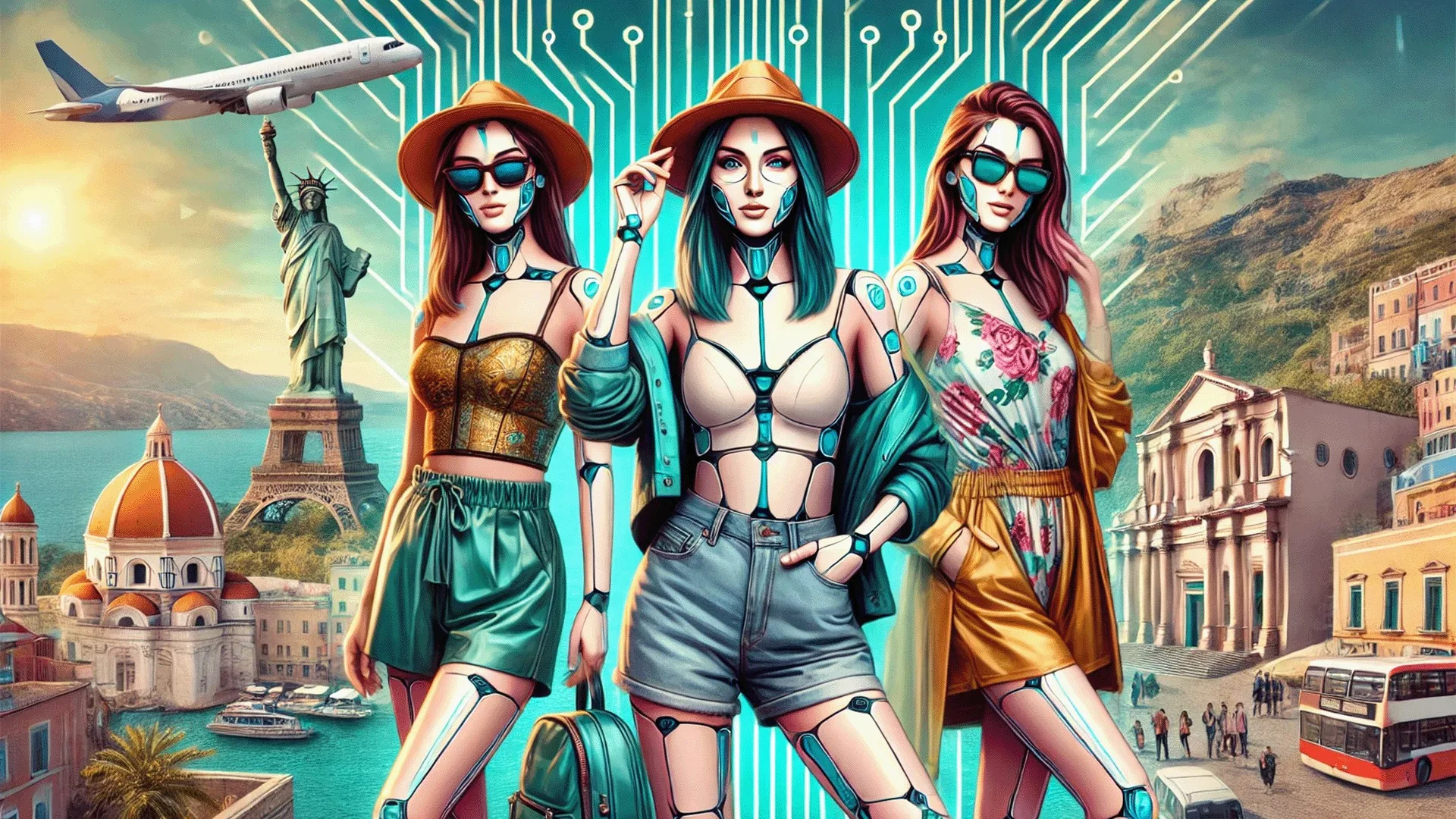In the evolving landscape of social media, travel influencers have long been the modern storytellers, captivating audiences with wanderlust-inducin
In the evolving landscape of social media, travel influencers have long been the modern storytellers, captivating audiences with wanderlust-inducing photos and expert recommendations. However, the rise of artificial intelligence has transformed this niche in an unprecedented way. Enter Emma, Sena, and Nyah—AI-generated personalities posing against stunning backdrops, from Ibiza’s sunlit coasts to the iconic architecture of Santorini. These influencers are not flesh and blood but digital constructs powered by advanced AI technologies like DALL-E and Midjourney. As they gain traction, their presence sparks a debate that’s difficult to ignore: Can you trust travel advice from an influencer who’s never set foot outside a server room?
A New Breed of Influencers
Emma, who has become the digital face of Germany’s tourism board, introduced herself to Instagram in front of Berlin’s Brandenburg Gate. Her perfect blonde bob and crisp British accent are products of machine learning, not human genetics. Meanwhile, Sena Zaro, a collaboration between Cenizaro Hotels & Resorts and AI consultancy Bracai, shares curated travel insights while looking convincingly real. Nyah, another synthetic personality, flaunts sun-kissed skin in Santorini, inviting followers to buy gifts or subscribe for more exclusive content. Their creators see them as trailblazers, offering innovative ways to inspire travel. Critics, however, question the ethics and authenticity behind these AI-generated figures.
Why Brands Are Turning to AI Influencers
AI travel influencers offer undeniable advantages for brands. They are tireless, error-free, and—most importantly—cost-effective. There are no plane tickets, hotel stays, or per diem fees to worry about. According to Angeli Gianchandani, a marketing expert at NYU, these virtual personalities can be “on 24/7 across different platforms, across different regions and countries.” Emma, for example, speaks more than 20 languages, making her a versatile tool for international outreach.
The appeal isn’t limited to logistics. AI influencers can be tailored to represent any demographic or aesthetic, ensuring that brands can strategically cater to their target audience. But while this may sound like a win for companies, it has left real travel influencers and content creators worried about their future.
The Authenticity Problem
“Can you trust a travel influencer who’s never traveled?” This question resonates deeply with human content creators like Christina Dubin, a digital producer living in Geneva. “When people plan trips, they want to know what they’re actually going to experience,” she said. Emma, Sena, and Nyah may offer dazzling photos and seemingly sincere advice, but their experiences are nothing more than algorithmic constructs.
The disconnect becomes even more apparent when considering how AI influencers interact. During Emma’s launch by Germany’s National Tourist Board, social media comments were swift and divided. While some applauded the innovation, others felt it was a betrayal. Tour guide Kirstin Hertel-Dietrich, based in Würzburg, Germany, expressed her concern that such initiatives “promote digitization in the worst possible way” in a world already wary of deepfakes and misinformation.
The Human Touch: Why It Still Matters
Despite the technological marvels behind AI-generated images, there’s an inherent appeal to human storytelling that algorithms struggle to replicate. Real influencers share raw, unscripted moments and personal anecdotes that resonate with followers on an emotional level. Whether it’s a video of a travel mishap or a heartfelt recommendation for a hidden gem, these experiences are grounded in reality, adding an authenticity that AI, for all its prowess, cannot replicate.
AI influencers like Emma may know the top tourist spots in Berlin or Cologne, but they can’t share what it feels like to stumble into a quaint café during a rainstorm or to exchange stories with locals over a late-night drink. This type of storytelling is what gives human influencers their staying power and continues to build trust with their audiences.
Send emails, automate marketing, monetize content – in one place
Behind the Curtain: How AI Influencers Operate
The technology driving these digital personalities is a mix of AI-powered image generation and sophisticated programming. Companies like Bracai, which developed Sena Zaro, create hyper-realistic images and pair them with pre-recorded human-written posts and videos. According to Finn Christian Arctander, Bracai’s founder, the goal is not to deceive but to inspire and inform. Still, the line between genuine inspiration and cleverly disguised advertising is blurry.
When an AI influencer posts about “top sites to visit,” it’s often backed by detailed research. For example, Sena’s guide to Marrakech includes the bustling Jemaa el-Fnaa square, the famed Koutoubia Mosque, and, conveniently, a Cenizaro hotel. Yet, without transparency, these posts can become ethically ambiguous, presenting travel tips as unbiased while subtly marketing specific brands.
Regulation and Disclosure: The Current Landscape
Meta, Instagram’s parent company, has begun implementing measures to label AI-generated content, but the effectiveness of such regulations is still debated. The platform’s AI labels rotate among disclaimers like location tags or music credits, which means users might miss these disclosures altogether. While Emma’s posts from the German tourism board are labeled, others, like many of Sena’s early posts, are not as transparent.
Claire Leibowicz, head of the AI and Media Integrity Program at the Partnership on AI, believes that comprehensive regulation is essential. Without it, AI-generated content risks becoming an unchecked force, capable of misleading consumers and diminishing the value of authentic content. “If every image is flagged, the term ‘AI-generated’ starts to lose its meaning,” she pointed out, emphasizing the nuanced nature of the issue.
Marketing Without Transparency
Bracai’s Arctander acknowledges that transparency can be a double-edged sword. While the company does not wish to deceive, openly stating that Sena is an AI influencer tied to a hotel brand might reduce her appeal as an inspirational figure. This approach is reminiscent of human influencers who sometimes obscure their paid partnerships to maintain a semblance of authenticity.
“When you have an influencer that’s sponsored by someone, it becomes very much direct marketing,” Arctander explained. The challenge lies in balancing honesty with engagement—a tightrope that AI influencers walk even more precariously.
Ethical Implications of AI Travel Influencers
The implications of AI-generated media extend beyond the world of travel. Followers of Emma might feel inspired to book a flight to Germany, while Sena’s audience could be nudged toward a stay at a Cenizaro property. But the presence of these influencers also raises critical questions about the ethics of automation and digital representation.
A major concern is the erosion of human employment. Influencers, photographers, and travel writers often rely on brand partnerships to make a living. The introduction of AI competitors threatens this ecosystem by offering brands a cheaper, more manageable alternative.
Moreover, the aesthetic perfection of AI influencers can exacerbate unrealistic beauty standards. While human influencers already face criticism for heavily edited images, AI creations take it a step further by being designed without flaws, perpetuating an unattainable vision of reality.
Who Holds AI Accountable?
While the tourism board in Germany insists that Emma’s role is supplemental rather than a replacement, the concern remains that AI will progressively edge out human content creators. Social media companies like Meta are slow to enforce transparency measures, which compounds the issue. Meanwhile, Claire Leibowicz warns of broader repercussions: “unregulated AI-generated media carries a really long list of potential harms,” she said, from the spread of misinformation to more sinister applications.
The Future of Travel Influencing
As technology continues to evolve, so too will the strategies brands use to reach their audiences. While some marketers may see AI influencers as a natural progression in the digital age, others argue that the loss of authenticity is a steep price to pay. The global creator economy, valued at over $200 billion, thrives on the human touch—be it through shared experiences, relatable mishaps, or heartfelt reviews. For many, an AI influencer will always fall short of that intangible connection.
Content marketing expert Cam Khaski Graglia notes that while AI might be capable of presenting polished, picturesque content, the fundamental human need for trust will always favor real people. “People do not trust them entirely because they are not human and they have been built for a purpose,” she emphasized.
What’s Next for Human and AI Influencers?
For now, AI influencers like Emma, Sena, and Nyah are unlikely to disappear, but their continued success depends on striking a balance. If used responsibly, AI can complement human content creators by handling repetitive tasks, filling in gaps, or expanding multilingual outreach. Yet, the spotlight remains on the platforms and governing bodies to enforce stricter regulations that ensure transparency and ethical practices.
Until then, the tension between synthetic influencers and their human counterparts is a reminder that innovation comes with trade-offs. While AI may offer efficiency and scalability, it lacks the warmth and trust that human creators bring. And when it comes to travel—an experience defined by the richness of human connection—followers may ultimately prefer the stories told by those who have felt the cobblestones beneath their feet and the wind in their hair.
Send emails, automate marketing, monetize content – in one place


